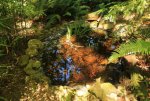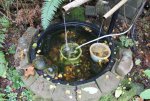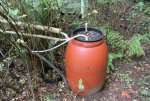Hello to all on the pond forum. My name is Dave. I live in the foothills of the Cascade mountains in north western Washington state (USA). There are 3 ponds here fed with biological sand water filters. One of these ponds has been here for 3 years with the filter running 24/7 (with the exception of time during freezing weather). The largest pond is slightly over 1 year old and about 500 gallons.
 This area is heavily wooded and there are lots of critters accessing the ponds regularly. Without filters, the ponds become horrifically foul. we've already been there and done that.View attachment 60187 I have a website and a blog where the work I have done on slow sand filters, over the past 7 years; and the info on the ponds and the pond filters is recorded. Several thousand hours of research on the website and blog. 8 working filters here, and 1 filter in testing mode.
This area is heavily wooded and there are lots of critters accessing the ponds regularly. Without filters, the ponds become horrifically foul. we've already been there and done that.View attachment 60187 I have a website and a blog where the work I have done on slow sand filters, over the past 7 years; and the info on the ponds and the pond filters is recorded. Several thousand hours of research on the website and blog. 8 working filters here, and 1 filter in testing mode.
There were fish in the original pond, but the raccoons ate them. We don't have fish in the ponds right now, the raccoons will just eat them if they can get at them. I am aware that there probably is a limit to the number of fish one can have in a pond and still maintain a clean environment for them. I am wondering if a slow sand filter may work? I am referring to a biological sand filter - no chemicals needed, sand does not need to be replaced - ever. Very low expense. I don't know about fish though. I wonder if anyone has actually tried using a slow sand filter system to maintain pond health with fish involved?
 This area is heavily wooded and there are lots of critters accessing the ponds regularly. Without filters, the ponds become horrifically foul. we've already been there and done that.View attachment 60187 I have a website and a blog where the work I have done on slow sand filters, over the past 7 years; and the info on the ponds and the pond filters is recorded. Several thousand hours of research on the website and blog. 8 working filters here, and 1 filter in testing mode.
This area is heavily wooded and there are lots of critters accessing the ponds regularly. Without filters, the ponds become horrifically foul. we've already been there and done that.View attachment 60187 I have a website and a blog where the work I have done on slow sand filters, over the past 7 years; and the info on the ponds and the pond filters is recorded. Several thousand hours of research on the website and blog. 8 working filters here, and 1 filter in testing mode. There were fish in the original pond, but the raccoons ate them. We don't have fish in the ponds right now, the raccoons will just eat them if they can get at them. I am aware that there probably is a limit to the number of fish one can have in a pond and still maintain a clean environment for them. I am wondering if a slow sand filter may work? I am referring to a biological sand filter - no chemicals needed, sand does not need to be replaced - ever. Very low expense. I don't know about fish though. I wonder if anyone has actually tried using a slow sand filter system to maintain pond health with fish involved?







